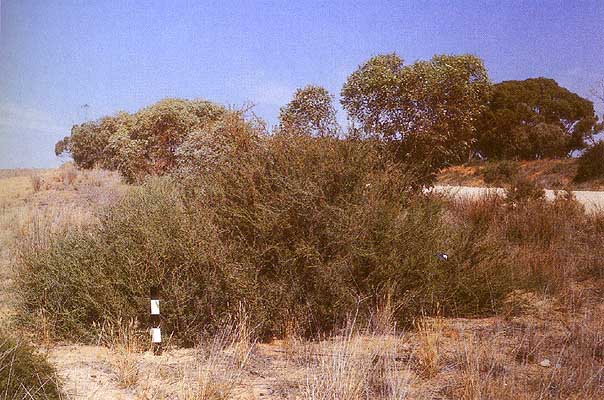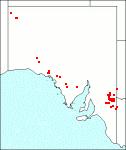Family: Fabaceae
Acacia acanthoclada

Citation:
F. Mueller, Fragm. Phyt. Aust. 3:127 (1863).
Derivation: akantha (Gr.)—a thorn, prickle; klados (Gr.)—a branch.
Synonymy: Not Applicable Common name: harrow wattle
Description:
Low, rigid, spreading, divaricately branched shrubs 0.75-2 m high; branchlets terete, whitish pubescent, tapering into hard sharp subulate points. Stipules readily caducous on older branchlets, triangular, small.
Phyllodes obovate, narrow-cuneate, 4-8 mm long, 2-4 mm broad, flat, rigid, ascending, hairy, upper margin humped and ending in a small main vein situated near lower margin, lateral veins few.
Inflorescences simple and axillary, solitary; flower-heads globular yellow, c. 30-flowered; peduncles usually longer than phyllodes; flowers 5-merous.
Legumes linear but usually spirally coiled, c. 3 mm broad, dark grey when mature. Seeds longitudinal in legume; funicle short, expanded into a thick aril.
|
|
Distribution:
|
Occurs on either side of the River Murray in the Murray region between Morgan and Renmark and also on western Eyre Peninsula and further inland near Immarna in the Nullarbor region. Mainly in open mallee scrub associated with Eucalyptus socialis and Eucalyptus gracilis. Soils; brown calcareous and sandy earths. Rainfall 250-500 mm. Also W.Aust., N.S.W. and Vic.
|
Conservation status:
Lang & Kraehenbuehl (1987) consider this species to be Rare to Uncommon in South Australia.
Flowering time: August — October.
|

SA Distribution Map based
on current data relating to
specimens held in the
State Herbarium of South Australia
|
Biology:
No text
Related taxa:
Appears to be closely related to Acacia bidentata which occurs only in the south-western province of W.Aust., but differs in the obovate or broadly cuneate-oblong phyllodes.
Cultivation:
A useful, small hardy ornamental low windbreak species with unusual foliage, suitable for inland areas, does well in well drained sandy soils. Moderate growth rate.
Author:
Not yet available
Source:

|

